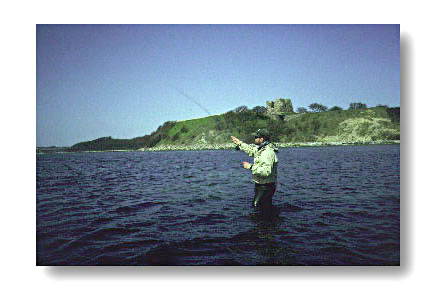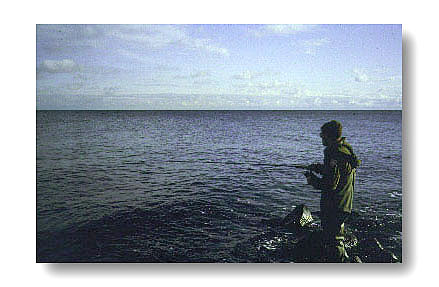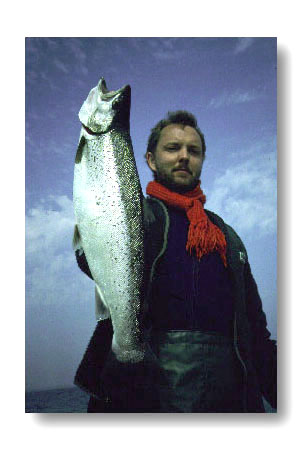|
Some days seatrout will eagerly strike
anything you throw at them. At other times they may have their
stomachs full and thus show no interest whatsoever in flies or
lures. They just follow the bait to the rod tip - with no ill
intent!
Still there are methods and baits that
produce fish on a more regular basis than others:
Fly Fishing
More and more fishermen realize that flies
fished traditionally on fly rod and fly line can be a very efficient
way of catching seatrout. Very often you do not need long casts
to connect with seatrout.

- Fly fishing for coastal
sea trout is becoming increasingly popular.
- © photo Steen Ulnits
In fact seatrout spend a substantial part
of their lives chasing bait in the shallows where they are easily
reached by fly casting. And very often, seatrout target small
food items when they really haunt the shallows.
When this is the case, fly fishermen stand
a much better chance of succes than their spinfishing colleagues,
simply because they are able to offer perfect imitations in a
realistic way.
Tackle
A 9-10 foot 7 or 8-weight fly rod is what
you need for most conditions. Lines should be weight forward
(WF) to handle the windy conditions often encountered and the
long casts sometimes needed.
In shallow water bay areas you may use
a floating line to advantage. But if you are fishing open coastlines
where wind and waves are the norm, an intermediate line is to
be preferred. It slices through the wind better than a floating
line and it sinks just below the surface. Thus it is not affected
but wind or waves. Instead it keeps a straight line all the way
out to the fly, making it easier to detect subtle takes.
A line tray is immensely practical
if you fish where rolling waves, rushing currents and floating
seaweed will otherwise grab your line and interfere with your
casting. Once you get used to it, you will never want to be without
it.
Leaders should be around 12 foot if you
are fishing with a floating line - 9 foot if you have an intermediate
line on your reel. Tippets in the 0.20-0.25 mm class are adequate
- with 0.20 being a good choice on calm and sunny days with clear
water. - Don't go any lighter than 6 lbs. test!
A saltwater resistant reel finishes off
the equipment needed. You can get by with a click check but disk
drags are much preferred if you encounter big fish. For that
very reason you should never go fishing in Jutland, Denmark without
at least 100 yds. of 20 lbs. backing to support your fly line.
Flies
Seatrout flies for fishing in the salt
usually are divided into two categories: Imitative flies that
aim to represent specific food items on the trout's menu. And
provocative flies whose only goal is to excite the fish into
striking.

- Big flies produce big
sea trout in the salt!
- © photo Steen Ulnits
Gaudy fantasy flies - fluorescent or not
- generally work best during wintertime where water is cold and
food scarce. During summer when food is abundant, flies that
imitate of represent specific food items - bait fish, crustaceans
or worms - are needed.
If you plan to go night time fishing, big,
black and bushy flies are preferred. Muddlers and Zonkers can
be fished in or just below the surface where they draw waves
and push water, making it easier for the seatrout to spot and
catch them. Often, you will hear the strike before actually feeling
it!
Thus, the well-prepared fly fisherman carries
several types of flies in his box. He will have small, shrimp-like
flies size 8-12 ready for those days where only small flies fished
deep and slow will produce. And he will be watching for the sligtest
indication of a subtle take that requires an immediate strike.
He also carries big and gaudy size 2-6
streamers for those memorable days when trout are feeding like
mad, slamming into longshank flies fished fast just below the
surface. This is often the case on windy and rainy days where
small flies will usually be left untouched.
The right retrieve
Generally, small flies should be taken
home slowly in short strips. Large flies should be retrieved
in long and fast strips. And as always it is important to vary
the speed of retrieve according to the water temperature. Fish
being cold-blooded respond instantly to changes in their environment.
So be sure to fish your flies slowly when
the water is cold and fish are sluggish. And faster when the
water is warm and fish feed actively.
If you carry the following flies in your
box, you will be able to handle most situations you will encounter
along the coastline of Jutland, Denmark. They catch fish all
year round:
"Mysis"
# 8, 10
"Magnus"
# 6, 8
"Mickey Finn" # 4, 6, 8
"Black Zonker" # 2, 4, 6
"Juletræet" ("Christmas Tree") # 2, 4, 6
It always pays to pay the local tackle
shops a visit. They know what fly or flies are the most productive
right then and there.
Spin Fishing
Spinning is the most commonly practised
method of catching seatrout from the shoreline. It's a method
where long casts are possible and much water can be covered in
a dayís fishing.

- Spinning is an effective
way of catching sea trout from the beach.
- © photo Steen Ulnits
Spinning is used by the majority of fishermen,
and spinning therefore produces the majority of fish caught.
Generally, larger fish are caught by spining than by fly fishing
- simply because most big fish tend to stay in deeper water,
outside the reach of fly casting.
An 8-9 foot long spinning rod capable of
casting 10-20 g lures will handle most conditions. A medium sized
fixed spool reel filled with 200 metres of 0.20-0.25 mm monofilament
line completes the outfit. Add an assortment of pirks, spoons
and wobblers but don't forget a handfull of flies for those days
where seatrout time and again follow your lure to the rod tip
without taking.
Good producers are spoons like Toby, Smelt,
Sølvpilen and Jensen Tobis. Shoreline wobblers like Gladsax,
Hingsten and Kutlingen should be in every fisherman's tackle
box. These lures can be fished very slowly without hitting the
bottom. Thus they are ideally suited for wintertime fishing in
cold water where fish are sluggish.
During spring and autumn where the water
temperature is ideal and fish fed actively, you normally get
the best results using a fairly fast - and varied - retrieve.
Baitcasting reels and shoreline wobblers
When seatrout have reached a certain size,
food found in shallow water no longer seems able to fill their
stomachs. They need larger prey and the easiest way of achieving
this goal is to seek deep water where schools of herring, sprat
and sand eels abound.
Long casts with heavy tackle and large
shoreline wobblers fit the bill if you want to catch these big
fish. And you are advised to seek open coastlines offering deep
water close to shore. Secluded brackish-water bays only rarely
yield large herring feeders.
If you want to make the most of this specialized
kind of seatrout fishing, you need a powerful 9-10 foot spinning
rod plus a medium-to-large sized spinning reel or better yet,
a multiplying reel capable of handling 200 metres of 0.25-0.30
mm monofilament line. Or equivalent unelastic PE-line of even
smaller diameter.
Add to this an assortment of 20-30 g shoreline
wobblers in natural colour combinations - silver with black,
blue or green backs. In the wintertime provocative colours like
hot fluorescent pink and orange are often a better choice.

- A 4 kg sea trout is
always a prize catch -
- one that should be treasured.
- This author was pleased!
- © photo Steen Ulnits
Choose between Danish classics like Gladsax,
Sandgrævlingen and Kongetobisen - all plastic moulded.
In fact it was Denmark who came up with the first ever specialized
shoreline wobblers for long distance casting - heavy wooden plugs
that took up water and left the paint peeling... But they cast
the required distance and they caught fish!
Ultralight spinning
At the opposite end of the spectrum we
find the light line enthusiasts - the UL or ultralight fanatics.
They swear by long and limber 9-10 foot spinning rods capable
of casting tiny spoons and spinners weighing no more than 2-12
g. Reels are small fixed spool spinning reels filled with 0.15-0.20
mm monofilament line.
This is yet another way of fishing that
originated in Denmark - a method which has proved very productive
when seatrout are in the shallows searching for sticklebacks
and other small baitfish. Add to this the excitement of fighting
even a two pounder on tackle this light!
Mepps and Vibrax spinners size 1-3 are
good producers when long casts are not required. If more distance
or a faster retrieve is needed, focus on small spoons like the
classic Toby and Æbelø.
When it comes to local favourites amongst
flies and lures, do pay the local tackle shop a visit. They know
what works in their waters and they also know where the best
fishing can be found at any particular time.
The right retrieve
When casting lures from the coastline,
you should always opt for a varied retrieve. A lure speeding
up and slowing down has much more appeal to hunting fish than
a monotonous retrieve of the same lure.
Very often the fish will strike when you
speed up the retrieve. Fish often follow the lure for long distances
without striking. But when they sense that their potential food
is trying to get away, the strike comes almost automatically.
Still you will often encounter the so-called
"followers" - fish that have a hard time deciding whether
to strike or not. Fish that not even a varied retrieve can lure
into striking.
If this happens to you, try letting your
spoon or plug drop towards the botton - with no retrieve at all.
Often seatrout will pick up the lure immediately - as if afraid
it would escape. As if it was some sand eel trying to bury itself
in the bottom. At other times the fish will not strike until
you start the retrieve again.
Bubble floats and
flies
If necessary, the spin fisherman has yet
another ace up his sleeve. By using a so-called "bubble
float" which can be filled more or less with water, he may
in fact fish very small flies on very long casts.
The water inside the float gives you the
weight necessary for long casts. And the small flies makes it
possible to imitate even the tiniest creature that seatrout may
have keyed in on!
The classic Bubble is round and transparent.
It is filed via two holes that can be closed. It has two line
eyes - one for the main line and one for the leader.
Modern Bubbles look different. They are
elongated and often made of hot coloured plastic that can be
seen from a long distance. Just like its classic predecessor
it is filled with water to add weight. Filled completely it sinks
slowly. Otherwise it floats. In this way you may adjust both
the weight and density of the float.
In modern Bubbles the line is threaded
through the float and fastened to a splitring or swivel. To this
the 2-4 m long leader is then attached - and at the end of that
the chosen fly of the day.
The idea behind this construction is that
you are always directly in touch with the fly through the float.
This makes it easier to detect subtle takes that would go unnoticed
with the classic Bubble. At the same time wary fish will feel
no or very little resistance from the float when they take the
fly.
The retrieve when fishing flies on Bubble
floats should be very, very slow. In fact so slow that many spin
fishermen do not have the patience needed for this most effective
way of fishing. You cast out the whole thing and then brake the
float with your finger just before it touches water. This is
to stretch the long leader so that you will be fishing from the
time of impact!
Leave the fly some seconds to sink before
you start the retrieve. Think of it as "crawling" the
fly back to you. Take half a turn of the handle and then pause
before the next half turn. If you want to make the most of it,
it takes several minutes to fish out each cast.
The flies needed for this particular kind
of fishing are the same as mentioned above under fly fishing.
Fishing the Water
Naturally, it pays to be able to make long
casts if you are to encounter seatrout on a regular basis. Long
casts let you reach distant fish and cover more water.
Still a surprisingly large percentage of
all fish are caught with 10-20 metres from the shoreline - a
fact which proves the productivity of the shallows when it comes
to fish food. It is also a reminder that you should never wade
into the water without having fished the shallows first.
Often you will find what we call a "bath
tub" - a deepening between the shoreline itself and the
first sand bank - very close to shore. If this is the case then
fish it thoroughly before wading out. Water in such a bath tub
is relatively stagnant and therefore warms quickly in early spring.
Seatrout know just that!
More often than in the bath tub itself
seatrout are to be found on the outside of the first sand bank.
Here they have easy and direct access to the protection of deeper
water. This makes them feel safer and, consequently, easier to
catch.
Fish carefully
Except for early in the year where warmth
from the sun is important for both fish and fish food, the shallow
water is always most productive during dark. Thus you will find
fish in close early in the morning and late in the evening -
plus all night long during the heat of summer.
When you are fishing a piece of coastline,
you cover the water by spreading your casts in a fan in front
of you as you walk or wade along. If you are fishing from a protruding
point or are standing on a large rock, you also cover the water
in front of you by casting in a fan. This way you search every
inch of water thoroughly so that any seatrout - if present -
will see your offering.
If wading is necessary, do so carefully.
Partly not to frighten any fish in shallow water - partly to
protect yourself agains unwanted dunkings... Where the bottom
is covered by round and slippery rocks, you have to move slowly
and feel your way forward. A wading staff will prove a great
help in such places.
Clothing
A large part of the seatrout fishing takes
places in the colder months of the year where water temperature
does not suggest a swim. But modern hi-tech products have taken
the sting out of cold. If you are wearing the right clothing,
you will be warm all day long - all year long.
Full length waders are required for most
seatrout fishing in Denmark. During summer you can easily get
by with a pair of thin nylon or PVC waders. If you can afford
it, breathable Gore-Tex is a sure winner. Then you will avoid
much of the sweating associated with long walks in hot weather
and waders.
Spring and autumn where water temperature
typically ranges between 5 and 15 degrees Celsius, warmer clothing
is required. As a minimum you need one layer of insulating fleece
between your body and your waders. A pair of 3-4 mm neoprene
waders is an investment you will never regret. With equipment
like that, cold has ceased to be a problem.
Come winter it is time to jump into thicker
4-5 mm neoprene waders. Add a pair of woollen gloves or better
yet - fleece which does not take up water and can be easily wrung
dry. Then winter can even be enjoyed!
The fly fisherman who has to handle a wet
flyline all day long, would be better off wearing thin neoprene
finger gloves - preferably with polypropylene inner liners to
wick away the inevitable condensation.
© 2006 Steen Ulnits
|

